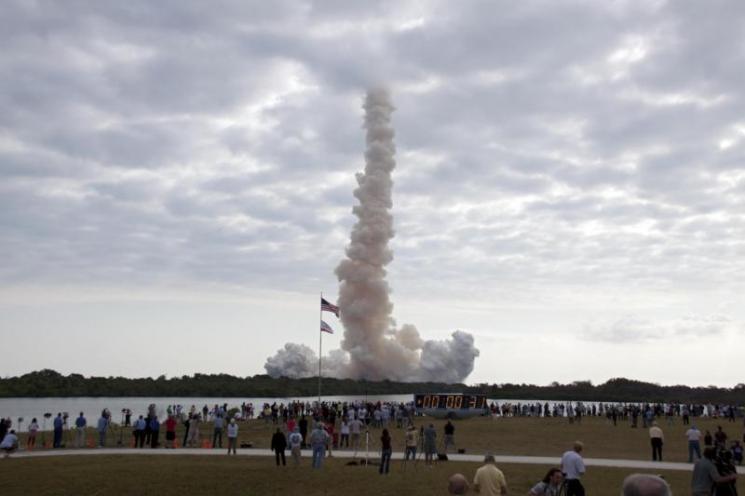
Smoke cloud from Endeavour's Final Launge | Photo: NASA, Troy Cryder
A flash and a flame . . . a rush and a roar . . . a bright white bird booming into a deep blue sky: Few science experiments ever begin in such spectacular fashion.
Yet the Space Shuttle Endeavour, which lifted off on its final mission Monday, did exactly that, starting a new science experiment that should tell us more about the universe in the years ahead.
Specifically, Endeavour was carrying the Alpha Magnetic Spectrometer (AMS) experiment, supported by the Department of Energy Office of Science. The experiment is led by Dr. Sam Ting, a Nobel laureate from MIT, who is supported by the Office of Science. When installed to the outside of the International Space Station, the AMS experiment will sweep the sky for cosmic rays. Despite their exotic name, cosmic rays are basically broken up bits of atoms – protons, electrons and atomic nuclei – which fly across the universe at near-light speed, driven by natural accelerators such as the enormous explosions known as supernovas. Since the earth’s atmosphere absorbs and blocks most cosmic rays, it’s necessary to position a detector in outer space to capture the rarest of them.
In addition to measuring how cosmic rays flow and what they are made of, the AMS will also search for cosmic rays made of a special form of matter known as antimatter. Antimatter is like matter, but with generally the opposite charge. For example, a proton has a positive charge, and its antimatter opposite is the antiproton, which has a negative charge.
Dr. Ting and other scientists believe that some of those particles detected by the AMS could come from an even more exotic critter called dark matter. Dark matter is believed to make up nearly a quarter of the stuff that’s actually in the universe. (Dark energy accounts for an even bigger portion, but that’s a subject for a different endeavor.) So by looking for new particles in space via the AMS, scientists might tell us more about the composition of the Universe.
To capture those high particles moving at incredible speeds, the AMS will use a powerful, permanent magnet connected to a variety of sensors. Data collection is expected to start shortly after the AMS is installed, though analyzing the information will take time. In fact, more than 600 scientists and engineers from some 16 countries have worked on the AMS experiment. Its construction was actually centered at CERN, the European Organization for Nuclear Research, and many European states provided most of the financial support.
But much of the analysis will be done by scientists at the Department of Energy’s Office of High Energy Physics (HEP). HEP is dedicated to exploring the most fundamental questions about the nature of the universe, such as what are we made of and how did we get here?
Those are the answers we’re looking for. And they could come via the AMS, an experimental endeavor that rose on a pillar of flame.
For more information on the DOE Office of Science, please go to: http://www.science.energy.gov/.






